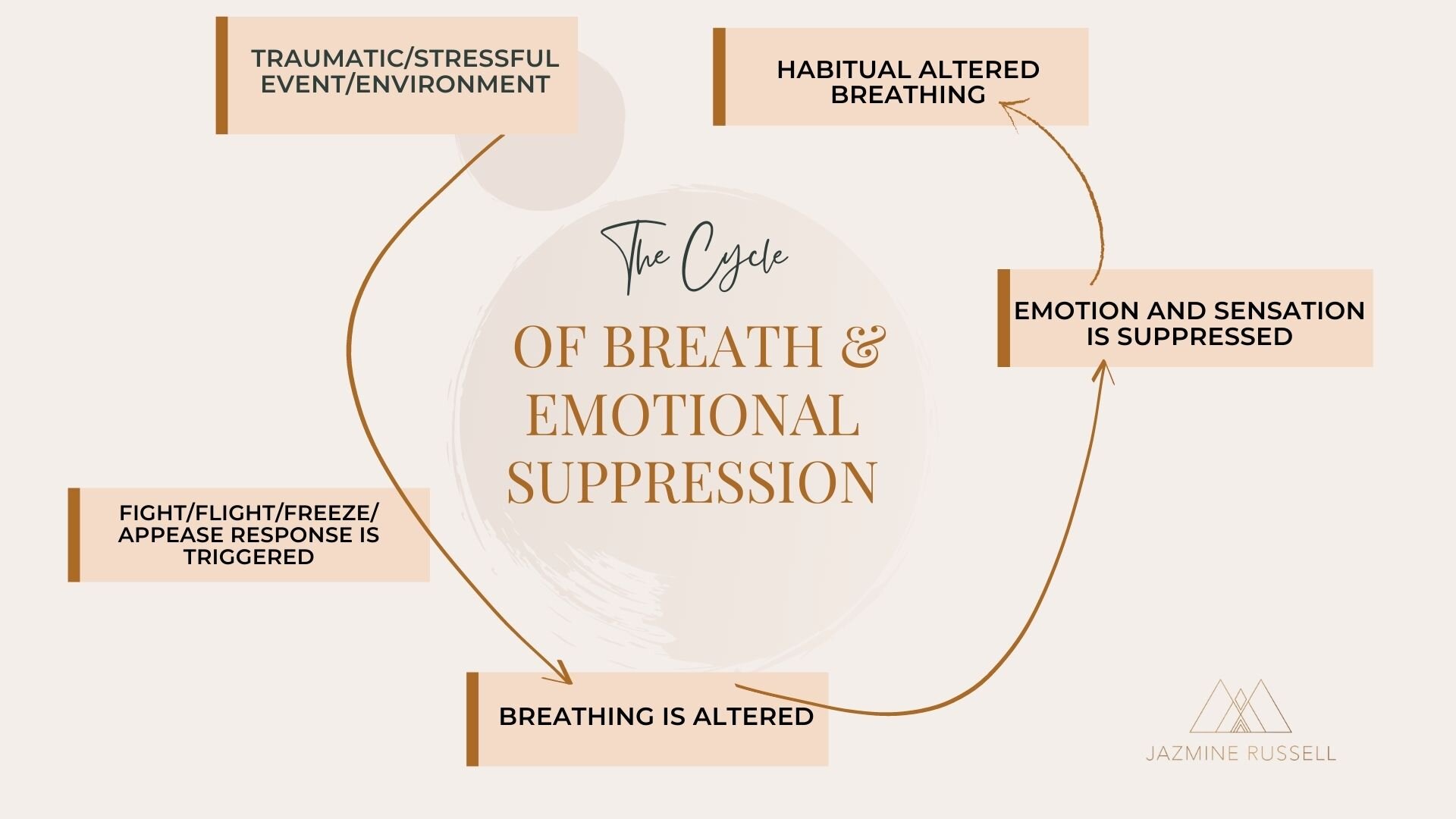The Science of Holotropic Breathwork in Healing Trauma
One of my favorite moments as a healer and practitioner is getting to witness the joy and ecstasy of someone coming out of a huge emotional release with immense insight, awareness, and power. The moment someone says "I never knew I could feel this good" or "Wow, it felt amazing to let that go". Often these moments come after a deep surrender - either a willingness to experience joy and bliss, or a willingness to feel pain and trauma, and accept parts of the self that were fractured, hidden, or shamed. After years of practicing as an experiencer and facilitator, my favorite way to access and return to a state of authenticity is through Breathwork.
What is Holotropic Breathwork?
Holotropic Breathwork is a healing modality, created by Stanislov and Christina Grof that combines rhythmic fast breathing, attention to the body and sensation, and evocative music to elicit transformation. People have used this form of healing for a variety of purposes:
to experience deep relaxation,
for deep emotional catharsis and trauma healing,
to achieve an altered state of consciousness associated with meditation and transpersonal experiences
In Holotropic Breathwork, every experience is unique and different. The breath leads you where you need to go - sometimes that's joy and laughter, sometimes it's tears and release, other times it's wisdom and clarity or a revelatory experience.
One of the core beliefs about healing in Breathwork is that breath is life force energy and that changes in our breathing, whether sharp and restricted or slow and full, bring about different somatic and emotional states. Using breath in spiritual practice or for healing is not a new concept:
"Since earliest times, virtually every major psychospiritual system seeking to comprehend human nature has viewed breath as a crucial link between nature, the human body, the psyche, and the spirit."- Stanislav & Christina Grof, Holotropic Breathwork: New Perspectives in Psychotherapy and Self-Exploration
However, scientists are now beginning to catch up with ancient knowledge and study the impact of breath as it relates to traumatic experiences, healing, and the nervous system.
The Cycle of Breath & Emotional Suppression
When we experience a threat, we unconsciously change how we breathe. If our nervous system kicks into "fight or flight" mode, we may experience rapid upper chest breathing. If we go into "freeze" mode, we may take only shallow breaths or hold our breath so as to go unnoticed. Much of this experience is automatic and slips below conscious awareness. If these reactions to trauma and stress in our environment go on for long periods of time, or we aren't able to re-experience safety, it can wreak havoc on the body and our emotions.
Some researchers suggest that the changes in breath are not just a nervous system response but also a way to keep the emotion or sensation suppressed when it's beyond our capacity to cope. A vicious pathway ensues and can be described as follows:
Traumatic/stressful event/environment ➜ Fight/flight/freeze/appease response is triggered ➜ Breathing is altered ➜ Emotion and sensation is suppressed ➜ Habitual altered breathing
Inhibited breathing can be a safety mechanism of the body to help us not get flooded with uncomfortable and painful emotions and sensations. However, over time we may develop holding patterns in the body and continue to suppress these emotions even when it would serve us to process and move beyond them. Practitioners of Breathwork suggest that removing the inhibition of breath and consciously deepening the breath can allow for emotional integration and regaining feelings of safety and relaxation.
Trauma researchers that focus on the sympathetic and parasympathetic nervous system have attempted to understand what can help people move out of these trauma and stress responses into a feeling of safety. Those who are proponents of the polyvagal theory suggest that the ventral vagus nerve is partially responsible for experiencing safety in the body and connection to others - which are often what survivors of trauma and extreme distress struggle with.
If you've experienced the impact of trauma, like myself, you may relate to being stuck in sympathetic nervous system activation:
shallow breathing,
restriction or tension in the belly,
holding your breath,
uncomfortable sensations throughout your body,
dissociation from the body,
feelings of not being able to relax, wind down,
not feeling grounded or connected to others.
All of these are indications that we may still be stuck in fight, flight, freeze, or appease mode, and stimulation of the ventral vagus nerve may be helpful in inducing relaxation.
Holotropic Breathwork can be supportive for trauma survivors in that it helps to bypass the conscious mind to evoke deeper layers of the psyche, is an embodied practice, and put awareness to our breath pattern that can support moving from fight/flight/freeze/appease and into more safety in the body.
Impact of Breathwork on Trauma
It’s important to note that Holotropic Breathwork doesn’t necessarily elicit traumatic memories or require people to relive them in order to heal. In Breathwork, one is free to express the emotions and sensations through laughter, tears, shaking, movement, and anything else that releases the emotional residue from the event. The power of Breathwork is that it allows the body to do what it already naturally knows how to do - release and restore.
While there is a need for much more empirical research on Breathwork as a modality and its impact on specific types of trauma, biological, and psychospiritual states, here are a few ways I have experienced and witnessed Breathwork assist powerful changes in the body, mind, and spirit:
1) Diaphragmatic Breathing & Vagus Nerve Stimulation
When we are stuck in fight/flight/freeze/ or appease mode, we tend to breathe shallowly and not utilize the diaphragm to take deep full breaths. This restriction, especially for those who have experienced extreme stress or trauma, can be habitual and unconscious. Breathwork is a practice that involves rhythmic diaphragmatic breathing. Diaphragmatic breathing in many settings and styles have been linked to a variety of positive outcomes, reducing anxiety, depression, blood pressure, PTSD symptoms, and insomnia. Diaphragmatic breathing is also associated with stimulation of the ventral vagus nerve to induce deeper relaxation. Three practices that some clinicians who specialize in trauma suggest to stimulate the ventral vagus nerve and promote relaxation are laughter, shaking, and humming. All of these are common for people to experience in Breathwork which can support integration and emotional catharsis.
2) Embodied Awareness
Breathwork is an active embodied practice. During Breathwork, many people report a greater awareness of the body and sensation. For trauma survivors, feeling embodied can be challenging and deeply uncomfortable. Living in the body means living in a place where abuse and pain has occurred. Breathwork elicits somatic sensation and awareness of the body in a deeply relaxed and uninhibited environment. Some people experience a greater trust in the body, growing an awareness that the sensations, pain, or tension are not a form of punishment or pathology but arises to bring forth integration.
3) Permission to Express
One of the biggest ways that trauma and stress can inhibit us is by suppressing our expression. Part of the healing process is learning to express anger, pain, sadness, and fear in ways that support our growth and our relationships. In Breathwork, all emotions, movements, and ways of expression are allowed (so long as they don't harm others or oneself). Many find the profundity of shaking, screaming, laughing, grunting, sighing, or feeling the freedom of expression in whatever way the body needs in order to heal. This permission is crucial for building self-trust. Often we mistake the ways we've been conditioned to swallow, stuff, hide, or repress our feelings with who we really are. Breathwork allows the space to connect with our truest feelings in a safe and supportive place.
4) Emphasis on Acceptance
Breathwork is conducted with no specific end goal, no pressure or expectation. The goal is to breathe and feel what emerges. This allows us to let go of the desire to "figure it all out" or to demand something of our bodies and minds. We breathe at our own pace and treat ourselves with gentleness. All emotions and sensations that arise are treated with a quality of acceptance - our anger, pain, joy, and physical sensation are all allowed to be. With acceptance, resistance decreases, our tolerance for discomfort and uncertainty increases, and we become more gentle with ourselves.
5) The Healing Power of Altered States
Breathwork has the potential to elicit altered states of consciousness, akin to a deep meditation. In this state, we have the potential to bypass mental stories, projections, judgements, and resistance that prevent us from healing. Breathwork opens the space to allow the body's inner intelligence to emerge and access our own innate wisdom. In altered states of consciousness, we have the potential to process in symbols, metaphors, and sensations that take us deeper than language and rationality. In altered states, we can access our subconscious true feelings without assessing, rationalizing, or mentalizing the experience. Meeting the experience in this way allows a much deeper release and integration.
If Breathwork feels like the right modality for you - check out 1:1 virtual Breathwork sessions here.
Much love,
Jaz




